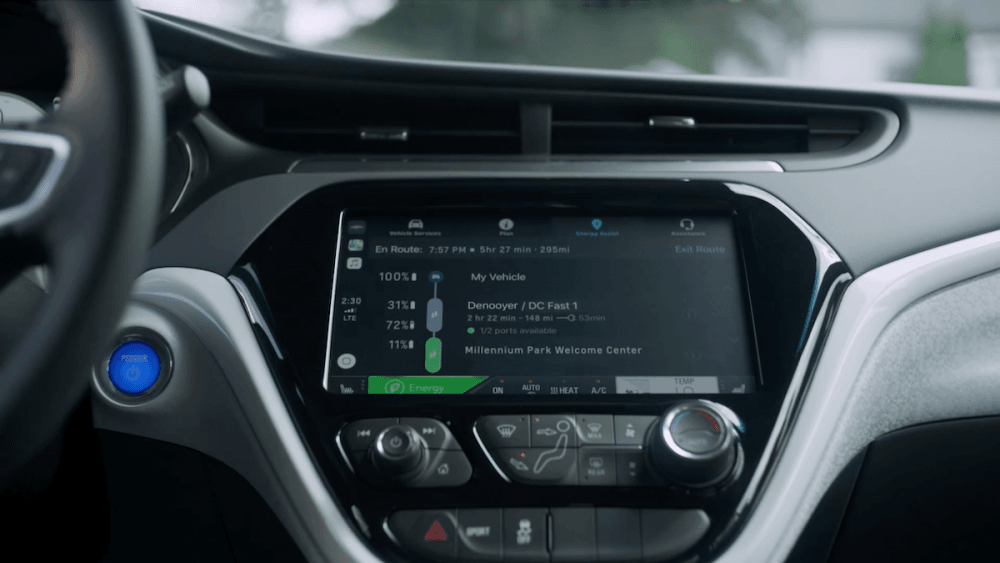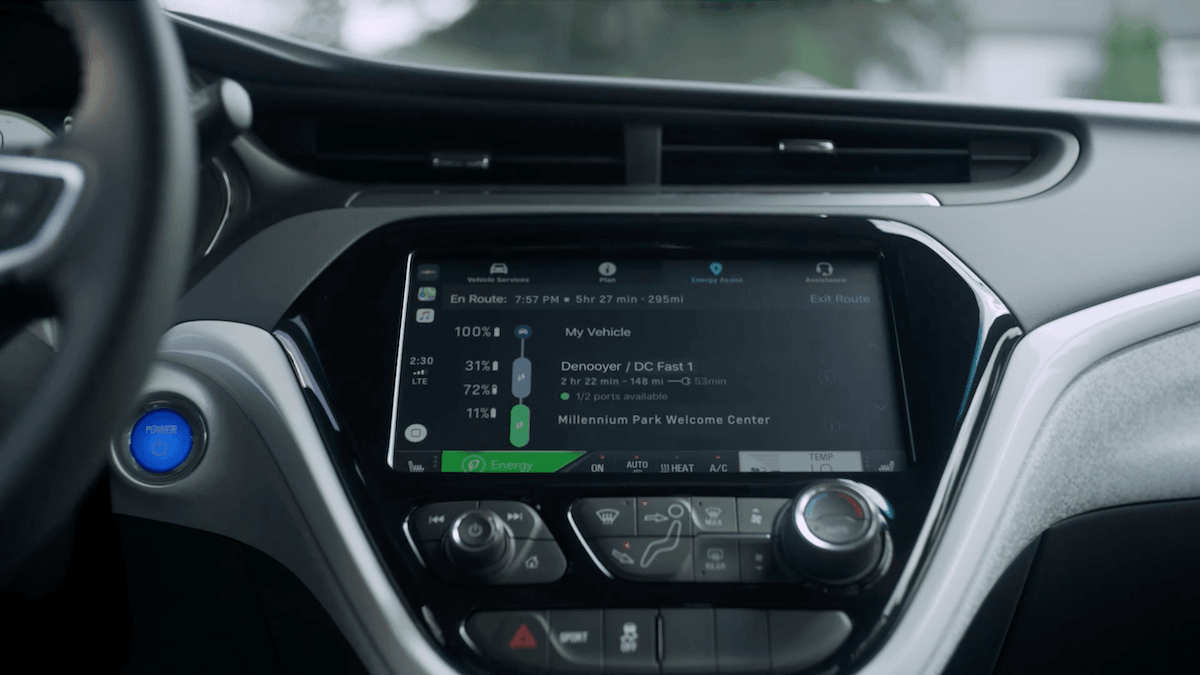
I could talk more about how the 2020 Chevy Bolt handles both scenic roads and highways equally well and how it can be suited to a family car, and thus would be great for road trips.
But that’s ignoring the big questions most people will ask about taking the Chevy Bolt EV on road trips: How far can I go on a single charge and how do I re-charge on the road?
Road Trip: 2020 Chevy Bolt EV: The Basics
The 2020 Chevy Bolt EV has a driving range of 259 miles on a full charge. That is an estimate.
The driving range can fluctuate higher or lower depending several factors: how you drive, the route you take, and if you’re using any accessories that require battery power. The big ones that draw power are the air conditioning and heating systems. The draw down from the heating systems can be mitigated by only using the heated seats and steering wheel rather than heating the full car but air conditioning obviously has to be for the whole car.
So generally, with highway driving at an average of approximately 60 mph, that’s approximately four and a half hours before you would have to stop to recharge.
Road Tripping: How to Plan Recharges
General Information
You probably don’t want to push the battery to the limit and instead search for a charging station with at least twenty miles of power left.
It’s the same principle as wanting to stop for gas before you’re lower than one-eighth of a tank. Of course, people push driving on empty all the time, as we all know it can mean anywhere from 5-10 miles left of gas for our respective cars. Why do we take the risk? Because we know we can find a gas station in that range. We’re so used to stopping to fill up with gas, we barely notice or plan for it in our road trips. There’s sure to be a station when we get that low fuel warning.
Being on a road trip with an EV can cause some anxiety when the green battery indicator on the dash goes lower and lower. But that anxiety isn’t necessary. Charging is possible without too many disruptions to the road trip, depending on where you like to stop, how long you like to stop, and how many times you like to stop.
I’ll say this right out: if you’re the type who wants to get into a car and drive straight through to your destination with a few quick stops, taking the Chevy Bolt EV on a road trip will not be for you.
But for families traveling with kids, frequent stops seems to be inevitable. Plan those “get the kids out of the car” breaks with stops to charge the Bolt, and the road trip will go well.
That is, if you plan where to stop. But know that you will probably have to stop about every 210 miles. That may change depending on whether you’re after a quick charge or a full charge, and, again, how you use the Bolt.
The good news about stopping to charge is that there’s an app for that.
In fact, there are several apps that will show the locations of charging stations for EVs, some that are designed to show all the charging stations near your current location (handy if you’re not a planner), some that will plan your trip based on where and how long you want to stop, and others that will also allow you to pay inside the app.
This is all good and no doubt experienced users of the app feel confident in the information they receive, but to someone doing it for the first time, the array of choices, especially the types of charging, can be intimidating.
Fast-Charging or Type 2/Level 2
The first thing you need to know about charging stations is which are fast-charging stations or Level 2 or Type 2 stations. Those are the ones that will give you 100 miles for each 30 minutes of charging. But not all stations are Type 2 aka fast charging. The app you’re using will tag them differently, so pay attention. A Type 1 station can charge your Bolt EV but it might take hours or overnight. Some hotels have them on-site or have them in walking distance, so a Type 1 is fine for that, as you’re staying overnight.
But if you want to get back on the road, Type 2 stations are needed. This is why I recommend getting the option of a Type 2 charger when you purchase a Bolt, as it’s not standard on the car.
The apps will detail which type of charge station is at each stop, if they’re in use, and some have feedback from previous users of the charger at this location. But some are frustratingly vague. For instance, if you’re staying at a Hilton hotel that night, can you use a charger at a Hilton location that’s on the way? Do car dealers allow you to use their chargers if you didn’t buy a car from them?
The amount of detail depends on the apps.
The Charging Apps
I wish I could tell you there’s one definitive app that you can use for an EV road trip, either in the Chevy Bolt or another EV.
But there isn’t because the network of public EV charging stations is not quite uniform. For instance, Tesla seems to be engaged in a Betamax/VHS war with the chargers needed for basically any other vehicle.
Non-Tesla users can’t use Tesla stations and Tesla drivers can’t use the stations that everyone else can. Note: there is a workaround. More on that later.
The bigger issue is that the EV infrastructure is not quite settled, meaning that different charging stations can appear on different apps and some charging stations will take one app for payment but not another.
On the good side, if you spend time planning, it’s going to work.
As a start with the 2020 Chevy Bolt EV, there’s the official app: MyChevy, offered by General Motors. The advantage of this app is that it’s used to your style of driving and so might give a more accurate assessment of how many miles you have left, taking into account the speed you drive on the highways, and the use of heat/cooling inside the car. It will locate compatible charging stations near your location and help you plan the trip. It will not include charging stations that are not compatible with your car.
But MyChevy might also miss some public charging stations. And it may not be possible to pay at this charging stations via the MyChevy app.
That means you also probably need a third party app. Those include PlugShare, ChargePoint, ChargeHub, EVGo, EV Hotels (useful for deciding where to stay overnight), and Open Charge App.
Yes, that’s a long list. I haven’t had the chance to try all of these out and none on an actual road trip. So far, I prefer PlugShare, as it plotted a trip from my home to Myrtle Beach, South Carolina, showing the charging stations along the route and providing options. I found out some interesting details, including the fact that numerous stations in the southeastern United States are located at Wal-Marts. Interestingly enough, it includes stops on numerous Wal-Marts.
Where you’re pro or con on Wal-Mart, there’s no denying it’s likely a good stop with kids, since they have rest rooms, food, and other supplies that you might have forgotten.
However, while PlugShare was great in planning the trip, I may need an EVGo or a Chargepoint account in order to pay for the energy at the station. Costs do vary on charging. Some stations are free. Prices on others vary but it’s usually close to what it costs to fill up with gas.
Until I can provide a first hand account of my own 2020 Chevy Bolt road trip, I recommend this article about road tripping with the Chevy Bolt. There are others but I would stick with the road trips from this year, as the availability of charging stations has changed (for the better) and the mileage has increased on the 2020 model.
One other wrinkle. It’s true that the chargers for Tesla EVs are not compatible on other EVs like the Bolt. However, it is possible to buy an adapter allowing a Bolt to charge at a Tesla station. That’s this adapter, but since things seem to change all the time with Tesla versus other EV charging, I would recommended testing it out before relying on it during a road trip.
Road Trip Conclusion: 2020 Chevy Bolt EV
It takes planning and extra effort on a road trip with any EV. However, there’s the added bonus of non-emissions during the trip, and the fact that traveling with kids tends to lead to frequent stops in any case, especially if you have kids who are insistent on knowing just how far you’ve gone and why you’re stopping.
Hey, given how kids love their apps, and given the WiFi hotspot inside the Chevy Bolt, I would recommend putting the kids to use in helping plan the trip. It gives them more control and it teaches them not only about road trip planning but also invests them in what needs to be done on a trip.






Two errors in this review: There are AC level 1 and level 2 chargers, and DC level 1 and 2 chargers, often called level 3. The fast chargers are DC which can charge the Bolt to 80% in about an hour. The level 2 AC chargers require overnight. The level 1 AC chargers are 110V home chargers that would take up to 2.5 days to fully recharge. The other point is that the adaptor only allows a Bolt to use a level 2 AC Tesla destination charger, not the DC superchargers.
Not so much an error as trying to simplify matters for those who don’t yet own an EV but, yes, of course you are correct.